After spending February until the end of May on loan at Bolton Wanderers last season, playing 21 league games and helping the Trotters to secure automatic promotion from EFL League Two to EFL League One via a third-place finish, Dapo Afolayan (182cm/6’0”, 73kg/160.9lbs) moved to the Macron Stadium on a free transfer this past summer, committing his future to Ian Evatt’s side permanently in the process.
Afolayan joined Bolton from EPL regulars West Ham United, with the 24-year-old having initially moved to East London from Solihull Moors back in January 2018. Despite ultimately making just one appearance for West Ham’s senior squad before departing this past summer, the Bolton attacker has put up some pretty impressive goalscoring numbers wherever he’s been throughout his career. In his final season with Solihull Moors, 2017/18, Afolayan scored 11 goals in 30 National League appearances, while he managed nine goals and five assists in a total of 32 Premier League 2 appearances for West Ham’s U23s, in total. The London-born attacker even managed to score in his only game for the Irons’ first team when he was given his debut by former Manchester United and Everton boss David Moyes back in January before his departure.
While he scored just once in his 21 league appearances for the Trotters last term, Afolayan has gotten off to an impressive start in front of goal this season, bagging four in his first seven League One games of the 2021/22 campaign.
In this tactical analysis and scout report focusing on the Englishman, we’ll provide analysis of some key talking points, strengths and weaknesses of the player’s game. Looking beyond just on-the-surface goal contributions, we’ll take a deep dive into Afolayan’s playing style to paint the full picture of what makes the ex-Irons attacker one of League One’s most exciting talents. This scout report reveals why Bolton manager Ian Evatt has openly declared that he believes Afolayan has “got a big future”, sharing all you need to know about this talent and his role in Bolton’s tactics.
Movement
Throughout most of his career thus far, Afolayan has primarily played as a centre-forward. However, during his time at Bolton both this season and last, the right-footed attacker has mainly been utilised at left-wing in Bolton’s typical 4-2-3-1 shape. The attacker tends to occupy the left half-space more than the wide area, especially when positioned further up the pitch, closer to the opposition goal. When positioned deeper, during an earlier phase of the attack, you’ll also commonly find Afolayan in the half-space channel quite a lot but he’ll be found wider during earlier phases more than in later phases too.
The Bolton man tends to be very heavily involved for his side in possession. He’s got a lot of influence over his team’s attack, which is evident in the fact that last season, he completed the second-most successful attacking actions per 90 (8.47) of any left-winger in League Two to have played at least 800 minutes of football. Meanwhile, this season, Afolayan has completed the third-most successful attacking actions per 90 (8.85) of any left-winger in League One.
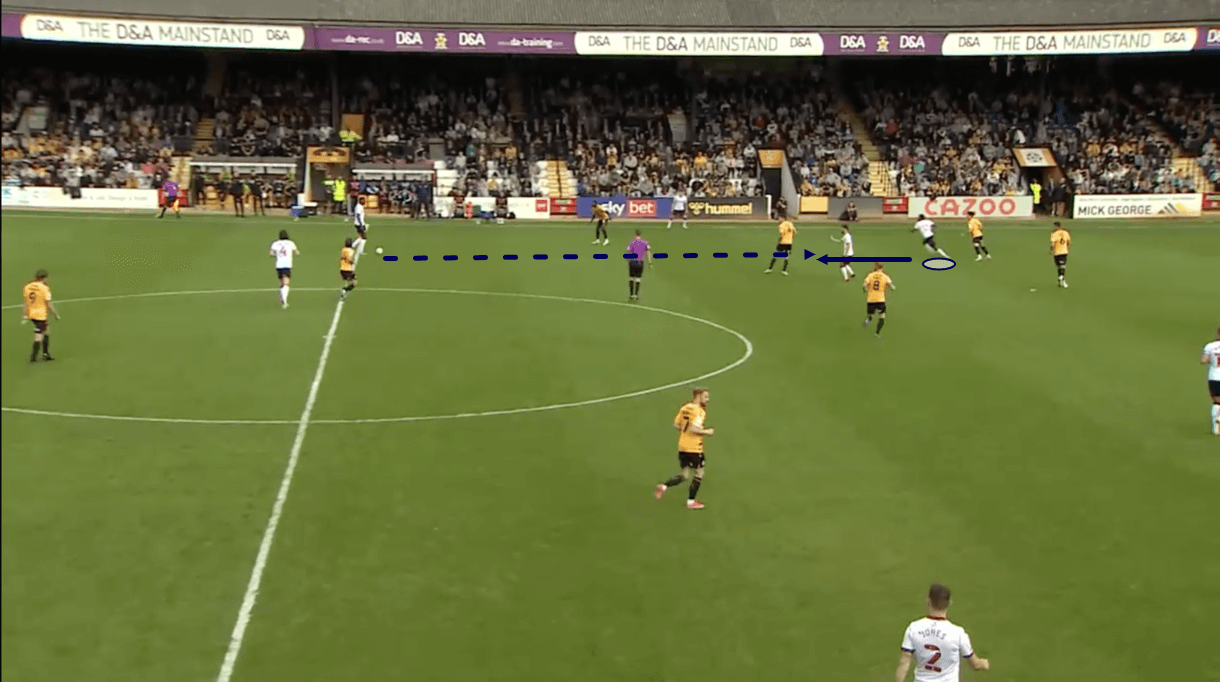
Intelligent positioning and movement play an important role in Afolayan’s heavy influence over his team’s attack. We see the first example of Afolayan’s positioning and movement in figure 1, where the 24-year-old is found in the right half-space while Bolton are in the ball progression phase. Just before this image, the opposition right-back marking Afolayan was touch tight to the Bolton man. However, after assessing the situation and seeing this passing lane open up, Afolayan takes the opportunity to link up with his teammate on the ball, dropping deeper, coming towards the ball-carrier and receiving this pass to feet.
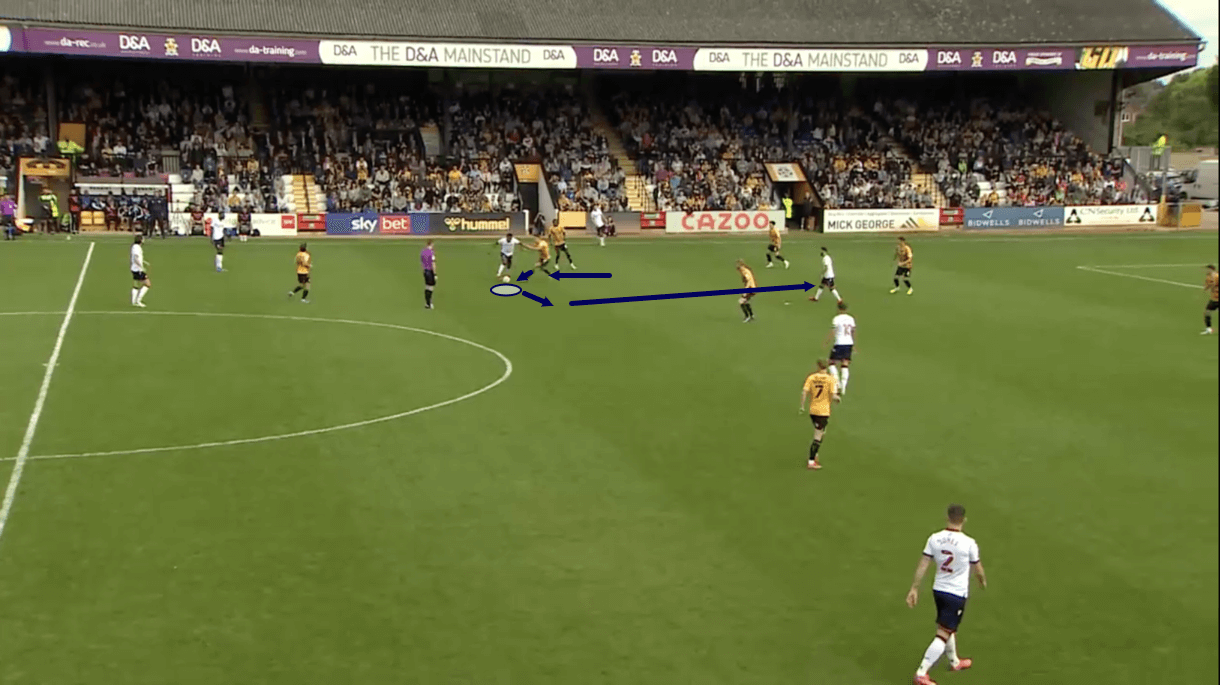
His movement away from the defender creates some space for himself to receive the ball more comfortably and begin turning, as we see in figure 2. As play moves on from here, Afolayan ends up back in the right half-space, essentially in his starting position, only this time, he’s in possession and he’s running towards the opposition goal instead of away from it with runners ahead of him including the Bolton left-back who attacked the space on the wing which Afolayan initially created when he shifted into the half-space and dragged the full-back with him.
This passage of play shows a clear example of how Afolayan intelligently manipulates the opposition’s defensive shape via his movement while linking up with teammates to create some chaos in the final third. The ex-Hammer has a great understanding of how to create/attack space.
As we saw here, Afolayan loves to receive the ball to feet. He’s happy to play with his back to goal and receive passes from deeper teammates like this. It’s very common to see him dropping off from the opposition backline like this passage of play showed to exploit space in between the lines or create some separation from a touch tight defender and he’s very good at finding space to exploit where he can receive the ball and turn with it to attack the opposition goal.
Even in more advanced positions than this, when his side are in the chance creation phase and the opposition are packed into a low-block, when it’s more difficult to find space ahead of the ball due to the opposition’s compact structure, Afolayan frequently exhibits really intelligent movement to pull away from the defender and become an attractive passing option just on the edge of the box similar to what we saw in figure 1 but maybe a bit more subtle.
Afolayan loves to link up with teammates in the final third. As we’ve established, he’s excellent at finding space in tight areas, and he’s also great at finding teammates in these areas too. The 24-year-old completed 1.44 deep completions (a non-cross pass that is targeted to the zone within 20 meters of the opponent’s goal) per 90 in League Two last season – the second-most of any left-winger to have played at least 800 minutes, while this season, he’s made 1.31 deep completions per 90 so far – also a very impressive number, which highlights his ability to link up with teammates on the ball inside the final third.
All in all, he’s really good at observing his surroundings and making subtle movements to find and exploit space, while he’s capable of finding teammates effectively in tight spaces too.
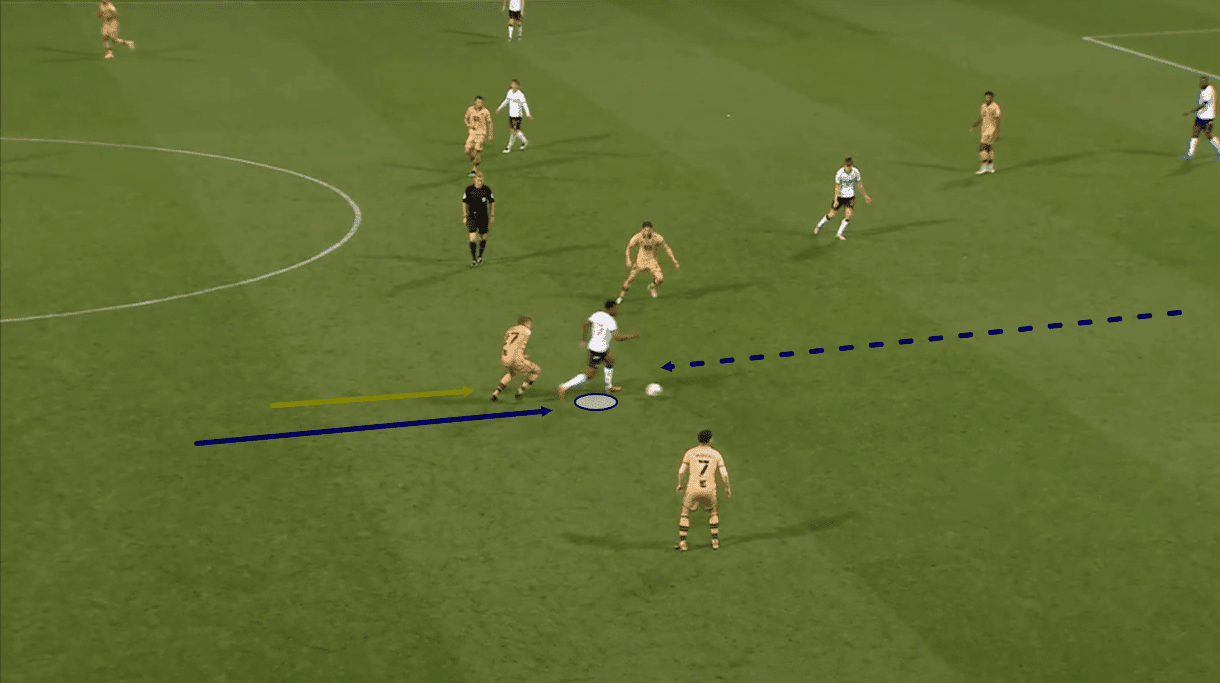
Figure 3 shows an example of Afolayan operating similarly during an earlier stage, however. Here, the attacker can be seen dropping deep into the left half-space during the build-up to help his team progress out of their own half. As mentioned earlier, you’ll sometimes find Afolayan positioned out wide during earlier phases like this one, whereas it’s much rarer to see him positioned out wide in more advanced positions. However, it’s still very common to see him occupying the half-space channel deep, during the build-up phase as we see here.
Again, as was the case for figure 1, Afolayan spots an opportunity to receive the ball to feet from his centre-back teammate, and so drops off from the defender marking him to create some space where he can receive the ball and turn with it. On this occasion, the defender follows just behind but the Bolton attacker still has all of the space he needs thanks to his movement.
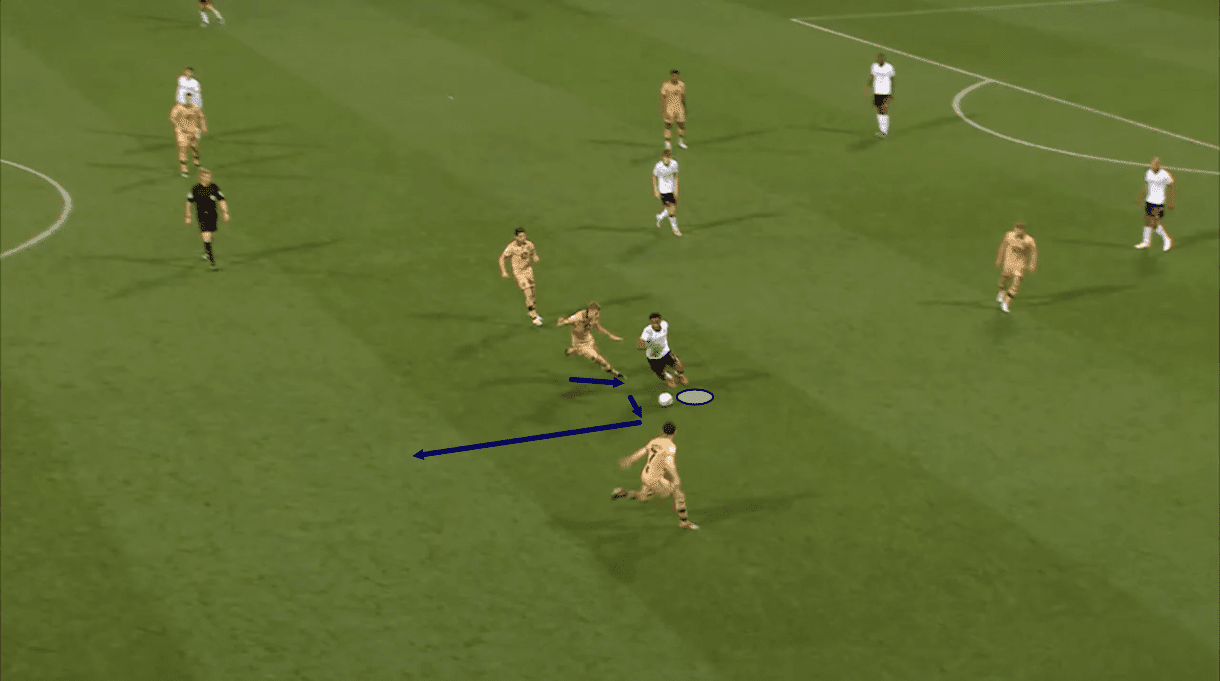
As play moves on into figure 4, we see that Afolayan receives the pass well and manages to turn despite the defender’s presence. He doesn’t need a lot of space to turn and drive at the opposition goal, as this image highlights, which makes his movement dropping off defenders into deeper space even more threatening because even if he’s followed like in this situation, the defender is unlikely actually prevent the attacker from enjoying enough room in which he can turn.
Figure 4 also highlights Afolayan’s impressive agility. The attacker has shown his ability to turn quickly and sharply while retaining possession and beating defenders, as was the case in this example. He demonstrates good hip mobility which helps him to make these movements, all the while running with power to ensure that he doesn’t just turn on the ball, but manages to pick up pace and get past the opposition defenders around him in the process. This is a useful tool for Afolayan and Bolton. In figure 4, the opposition defenders struggle to redirect their movement as quickly as Afolayan does thanks to his agility, while they also struggle to match him for pace once he gets facing the opposition’s half and moving upfield. This makes him so difficult to mark and may make him a problem for opposing coaches and players to spend a little bit more time thinking about in the future as he may require more attention to stop from being so effective.
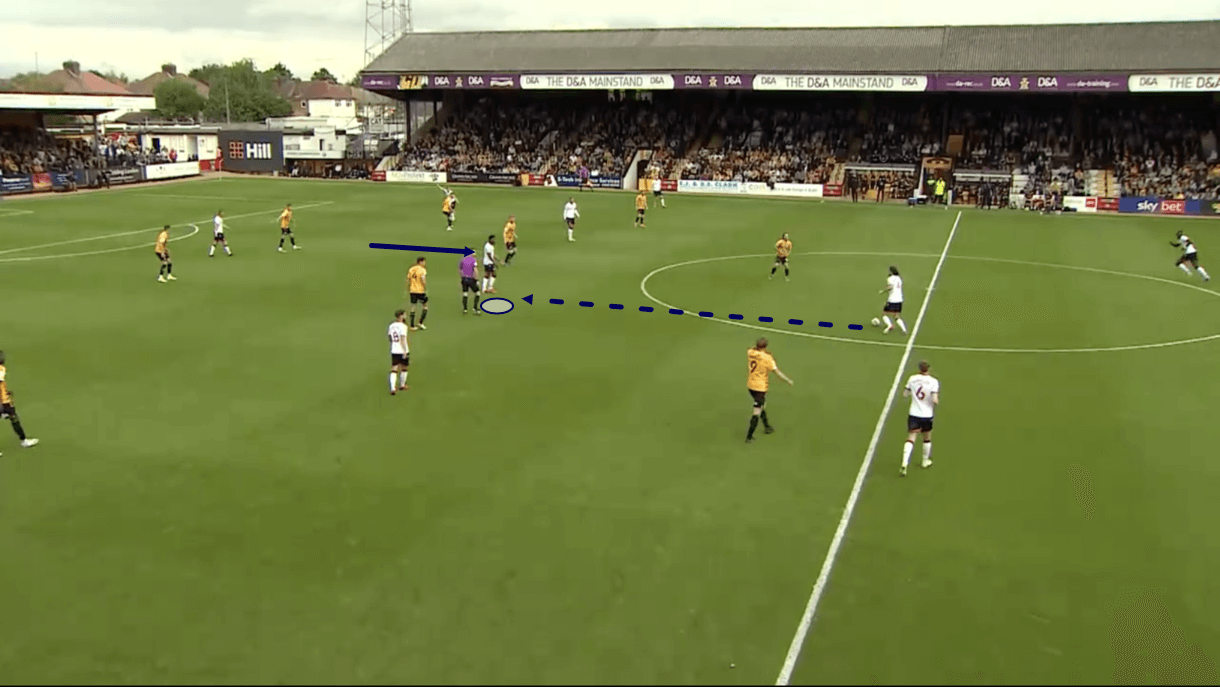
Again, you’ll primarily find Afolayan in the left half-space for Bolton but as his time at the Macron Stadium progresses and he develops more and more of an understanding and relationship with his teammates, we’re seeing him rotate into the ‘number 10’ position in Evatt’s 4-2-3-1 system more frequently. Afolayan will look to move into this position if the ‘10’ ends up naturally vacating it via movement of his own, creating space there in the process, as was the case in figure 5, where the ‘10’ ended up on the left and Afolayan moved into the centre.
The Bolton man is comfortable in the ‘10’ position when he needs to occupy it and operates very similarly to when he’s occupying the half-space. We see the familiar sight of Afolayan dropping off to receive a pass to feet in the ball progression phase in figure 5 while occupying space between the opposition’s two central midfielders.
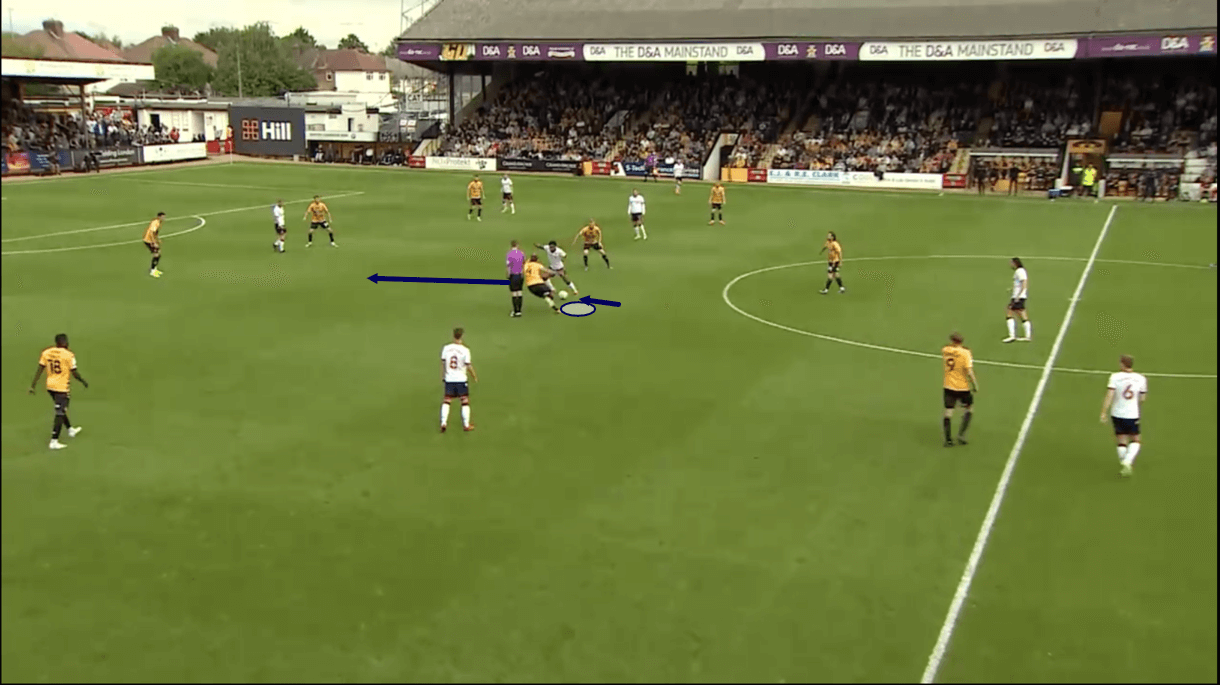
As play moves on into figure 6, we see that Afolayan’s teammate ultimately opted to make this pass into the attacker’s feet and as he did so, the 24-year-old received the pass on the half-turn, again demonstrating that ability to turn quickly and sharply while receiving the ball in a more dangerous position than the one it’s leaving, securing it and advancing the attack.
This passage of play highlights another element of Afolayan’s game, which is his ability to receive well on the half-turn in these advanced positions when there’s space behind him. In the previous two passages of play, we saw Afolayan moving towards the ball to receive while being followed by a defender. However, in figures 5 and 6, we see examples of the attacker receiving the ball with space behind him to turn into.
The Englishman rarely enjoys this space to turn into and is generally marked while dropping off into deeper positions but that wasn’t the case here when he rotated into the ‘10’ position and then dropped in between the opposition’s two central midfielders. Here, while Afolayan wasn’t afforded space on either side of him, the space behind was left open and he did a great job of turning to quickly exploit it while receiving the pass. This highlights the danger of giving Afolayan any space at all, as he’s great at spotting the space he can exploit and targeting it with intelligent attacking movement.
Dribbling and crossing
As mentioned in the previous section, Afolayan is heavily involved in Bolton’s all-round attacking play. One specific way in which the attacker gets heavily involved in his side’s attack is with his dribbling. Last season, Afolayan ended the League Two campaign with the highest number of dribbles (12.43 per 90) of any left-winger in England’s fourth-tier. Meanwhile, this season, he’s currently made the third-most dribbles (10.49 per 90) of any left-winger in League One, highlighting that the frequency at which he dribbles has remained fairly consistent and this part of his role in Evatt’s tactics hasn’t changed a great deal following the move from League Two to League One.
Additionally, last season, Afolayan had a decent dribble success rate of 54.59% in League Two, but he’s currently got a more impressive dribble success rate of 65.63% in League One. So, despite the frequency of his dribbling remaining consistent, his success rate hasn’t diminished despite the step up in level and has actually increased. Whether or not that will be the case for the long term remains to be seen, but it’s clear that Bolton rely on Afolayan’s dribbling quite heavily and he generally rewards them with positive dribble success.
As well as this, Afolayan ended last season having engaged in the most offensive duels (21.97 per 90) of any left-winger in League Two and has currently engaged in the most offensive duels (20.82 per 90) of any left-winger in England’s third-tier this season. As well as dribbles, offensive duels take instances of a player protecting the ball into account and it’s certainly common to see Afolayan do this. He’s a relatively strong player with a well-built frame and although he could improve his ability to protect the ball and maybe work on getting low and using his bum to legally push defenders away and create some space for himself after receiving a pass more frequently, he’s generally well able to hold his own in physical battles against defenders of a similar size to himself.
In terms of his dribbling, Afolayan is very technically impressive. He’s capable of keeping the ball close to his body, well under his control while moving at pace and taking on defenders. As we mentioned and observed in the previous section, he’s also very agile and capable of turning at pace while retaining control of the ball. He loves taking players on and attempting to dribble past them, which we see him do regularly throughout games, as is clear from the aforementioned dribbling statistics.
Afolayan’s dribbling quality is also highlighted by the fact that he’s managed to win more fouls (3.61 per 90) than any other player in League One this season. This is a result of his high dribble frequency along with his impressive dribbling quality. Afolayan is difficult to dispossess fairly because of his speed, agility, and ball control, so he’s an excellent asset on the ball in terms of the fact that a lot of the time, he’ll either progress through the opposition’s defensive shape or get fouled in the process of trying to do that.
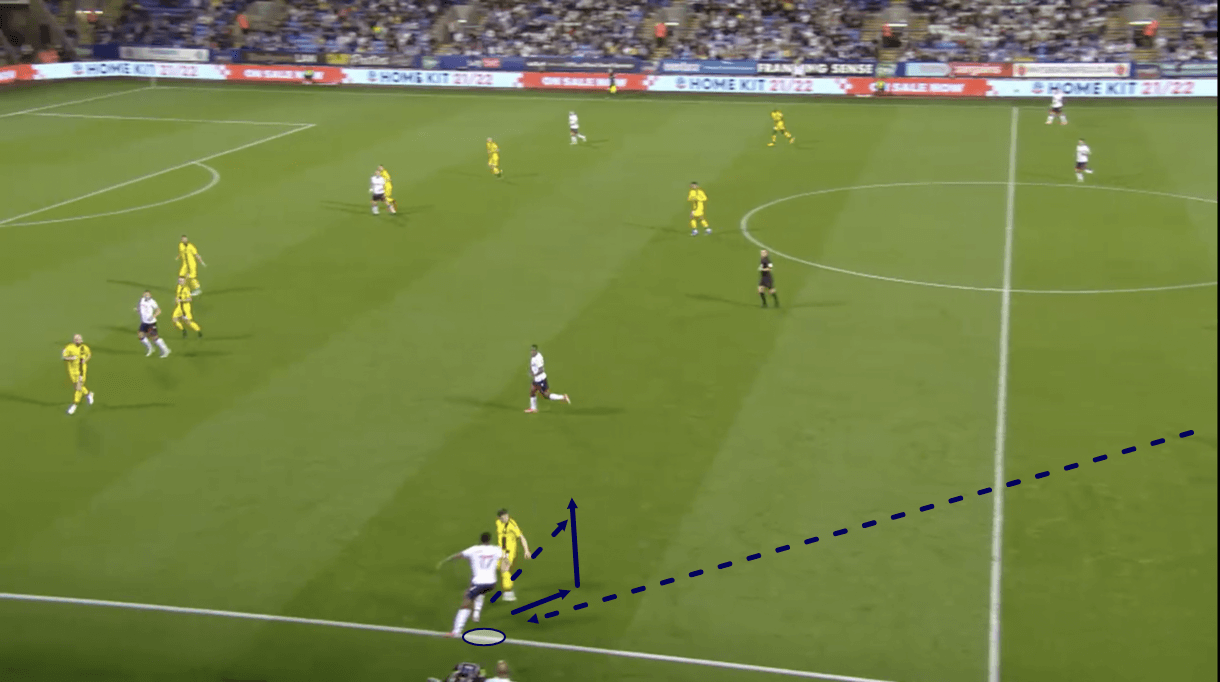
The passage of play beginning with figure 7 shows an example of Afolayan’s dribbling ability – on an occasion where he is occupying the wide area as opposed to a more central position. Here, we see the attacker receiving the ball out wide. An opposition player was drawn out to Afolayan as a result of the pass from the centre-back to the attacker on the wing. In a 1v1 situation, however, it’s very dangerous territory for a defender to get drawn into a 1v1 with Afolayan, as the attacker proved on this occasion. After attracting the defender towards him, Afolayan sent the ball through his legs and quickly darted around him, progressing into a more threatening central position.
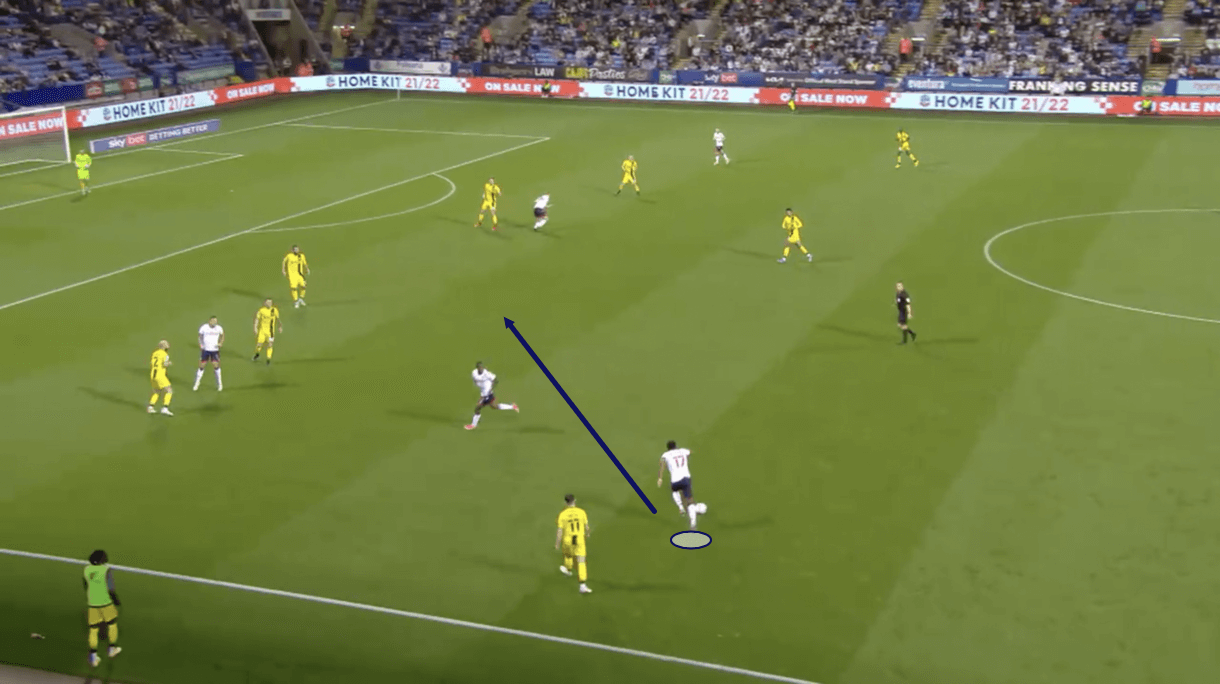
Figure 8 shows how Afolayan ended up with a lot of space in front of him to drive into and attack after quickly beating his man 1v1, and as play moves on from this, we see Afolayan attack this space, carrying the ball into the final third and putting his team in a far more advantageous position than they’d been enjoying when he initially received possession.
This image provides a clear example of Afolayan’s 1v1 ability. He’s intelligent to spot ways of getting past his man and wastes no time in exploiting them, reacting quickly as opportunities present themselves. Additionally, he’s pacey and well able to get away from his man after beating them, driving into space as we see here to push his team on.
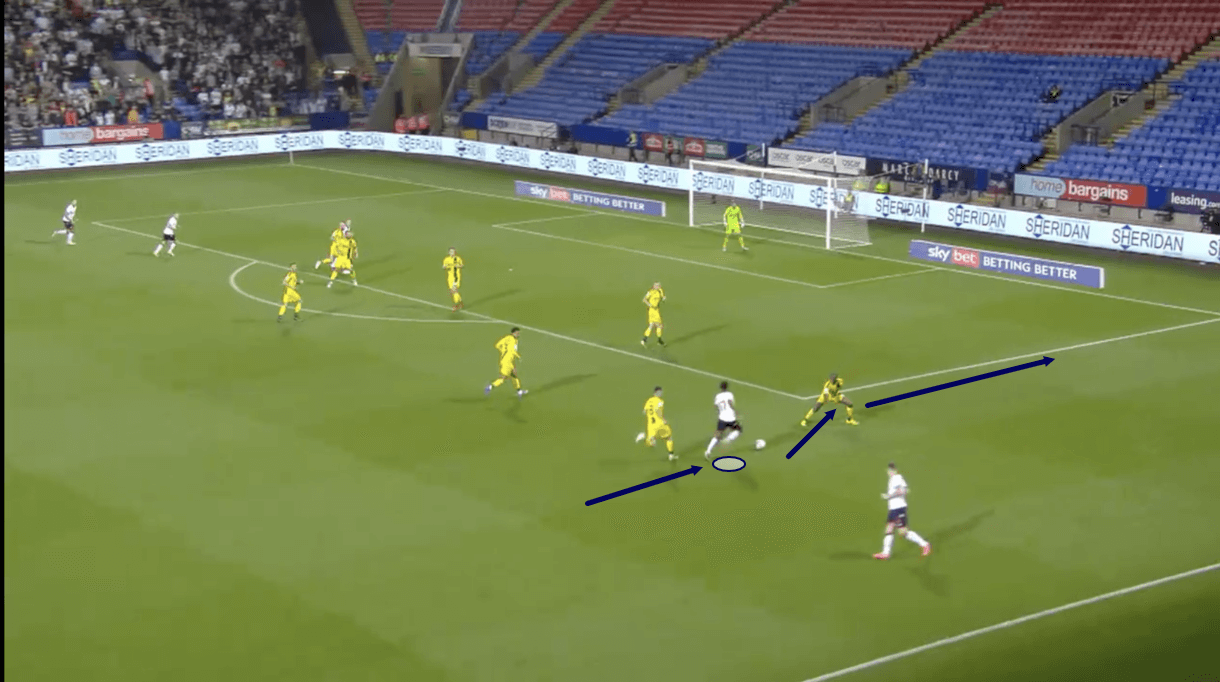
We see another example of Afolayan’s effective dribbling quality in figure 9. On this occasion, the attacker has popped up on the right-wing, where he operates infrequently but is also capable of playing to a good standard if required. Just before this image, the attacker received the ball and dribbled into the final third, ultimately reaching the position where we find him here. While moving at fast pace, he takes the ball past the opposition’s wide midfielder on the outside before engaging the full-back in a 1v1. Similar to the previous passage of play, Afolayan sends the ball through the full-back’s legs before progressing into a crossing position alongside the box.
As soon as he was past the full-back here, Afolayan was gone. He was moving at such a fast pace that the defender wouldn’t be able to catch up to him from a starting position, and this is where Afolayan’s ability to beat defenders 1v1 is so useful for him and his team. The fact that he’s able to get past defenders so frequently thanks to his ball control, speed, and agility helps him to get into space behind those players and once there, it’s very hard for the defenders to recover.
Another point worth noting on this particular passage of play is that here, Afolayan progresses into a crossing position on the right-wing – a fairly unusual position for him – and once in that crossing position, he opts to send a chipped ball into the box from around the depth of the six-yard box and just outside of the width of the penalty area. On the few occasions when Afolayan has ended up in a crossing position on the right-wing for Bolton, this has been the cross he’s most frequently opted for, with a low drilled cross from just inside the box also coming up frequently.
Afolayan hasn’t been incredibly effective with his crossing at Bolton, in general. However, he varies up his crosses quite a lot both on the right-wing and the left-wing, highlighting some diversity and unpredictability in his game which can help to make him a greater creative asset on either wing, should his team opt to use him there.
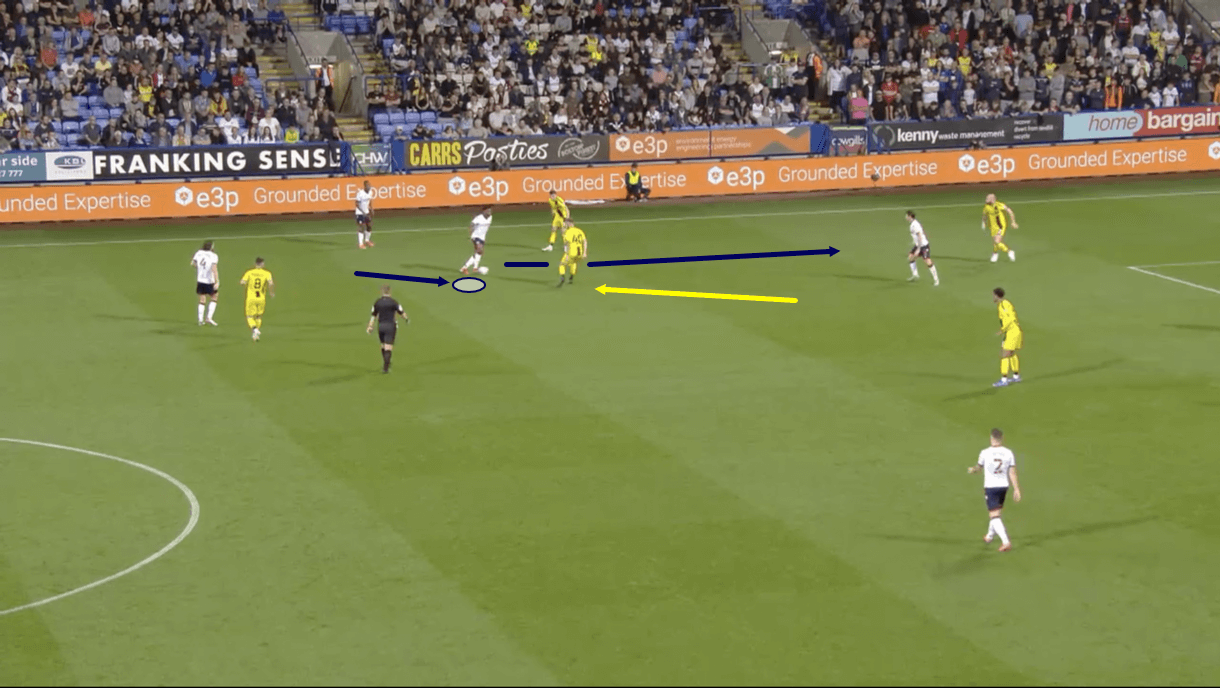
Figure 10 shows Afolayan on the left wing, just outside of the final third. Just before this image, the attacker received a pass from the left-back and as he received the ball, he quickly turned and got in position to face the opposition’s near central midfielder, who’s been attracted towards the Bolton man as a result of his threatening movement, and take him on 1v1. After taking a couple of careful steps towards the opposition player, Afolayan knocks the ball down the left wing, through the two opposition players just ahead of him, progressing past them with his pace and ultimately moving into a more threatening crossing position on the left-wing.
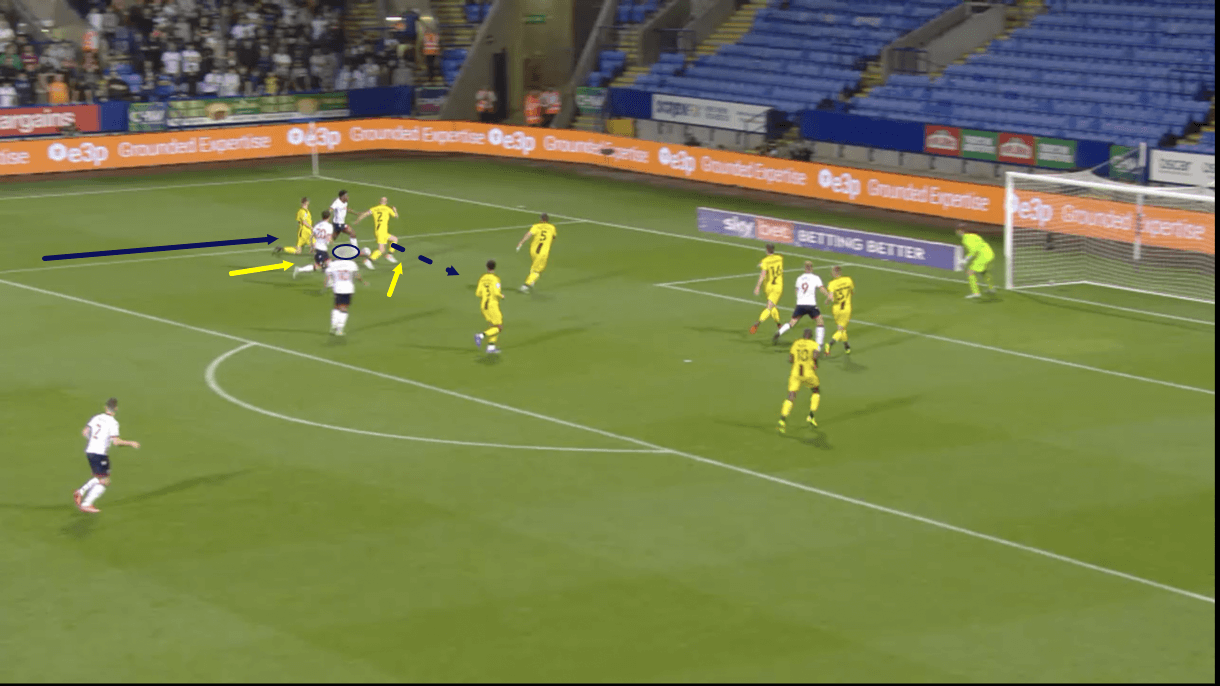
As play moves on into figure 11, we see that Afolayan manages to carry the ball all the way into the penalty box thanks to this dribble. The opposition midfielder who he passed just after turning is left chasing the Bolton man all the way into the box, with Afolayan almost leaving him as something of an afterthought, while the opposition’s full-back was hesitant to engage the pacey attacker in a 1v1 and essentially backed off until Afolayan had progressed into the box, where it would be more dangerous for the defender to try and tackle him for fear of conceding a penalty.
This passage of play highlights Afolayan’s threat as a ball-carrier. He’s great at using his technical quality and pace to drive past players in 1v1s, while his threat in 1v1 situations can also be enough to force defenders to back off and avoid engaging in 1v1s with him, which is better than being beaten but can still allow the attacker to progress into a threatening area, as was the case here.
As this passage of play moves on, we see Afolayan try to pull off a low drilled cross on his weaker left foot, which is blocked and results in his side winning a corner kick. As well as his dribbling quality, this passage of play highlights another of Afolayan’s common cross techniques – this low drilled cross from inside the box.
This cross is one of two cross types that Afolayan frequently attempts on the left-wing. He’ll almost always attempt this cross when he progresses down the wing towards the byline, getting within the depth of the penalty box. Alternatively, it’s somewhat common to see Afolayan pull the ball from his left foot back onto his stronger right foot when positioned slightly wider/deeper in the final third, before sending an inswinging cross into the box – generally targeting the back post but not always.
Again, Afolayan can improve the quality of his crossing. He doesn’t always put the desired amount of power on the ball and can misdirect the crosses at times too. However, in terms of varying up his crossing styles, he has a couple of different cross variants that he likes to utilise frequently from the left-wing in different situations. While the cross-type can be predictable depending on how he’s set the cross up, he’s not predictable in terms of what he does to set up the cross and due to how strong of a dribbler he is, he’s able to set up his desired crossing situations regularly and effectively get into positions where it’s difficult to stop him from executing the cross because of the effective dribbling work he put in beforehand.
Shooting
Lastly, we’ll spend some time focusing on Afolayan’s shooting. As mentioned at the very beginning of this tactical analysis piece, the attacker has been a fairly consistent goalscoring threat regardless of level throughout his young football career, and so far, that’s continued into the 2021/22 season with Bolton, as the ex-West Ham man is currently the Trotters’ top goalscorer in the league, having bagged four goals in his seven league games at this point in the campaign.
Afolayan is a high volume shooter. Last season, he took the fourth-most shots (2.64 per 90) of any left-winger to have played at least 800 minutes in League Two, while this season, he’s currently taken the fourth-most shots (3.11 per 90) of any left-winger in League One, so again, despite the change in level, Afolayan’s role at Bolton in terms of goalscoring attempts hasn’t changed and the attacker has rewarded Bolton for putting their faith in him as a finisher by scoring four in his first seven appearances of the season.
Afolayan is sometimes wasteful with his shooting opportunities. The Englishman ended last season with a relatively poor shot accuracy rate of 27.27%, while he’s currently got a shot accuracy rate of just 31.58% this season, which, again, is pretty poor. So Afolayan can definitely improve his shot efficiency and the level of threat he poses from shots.
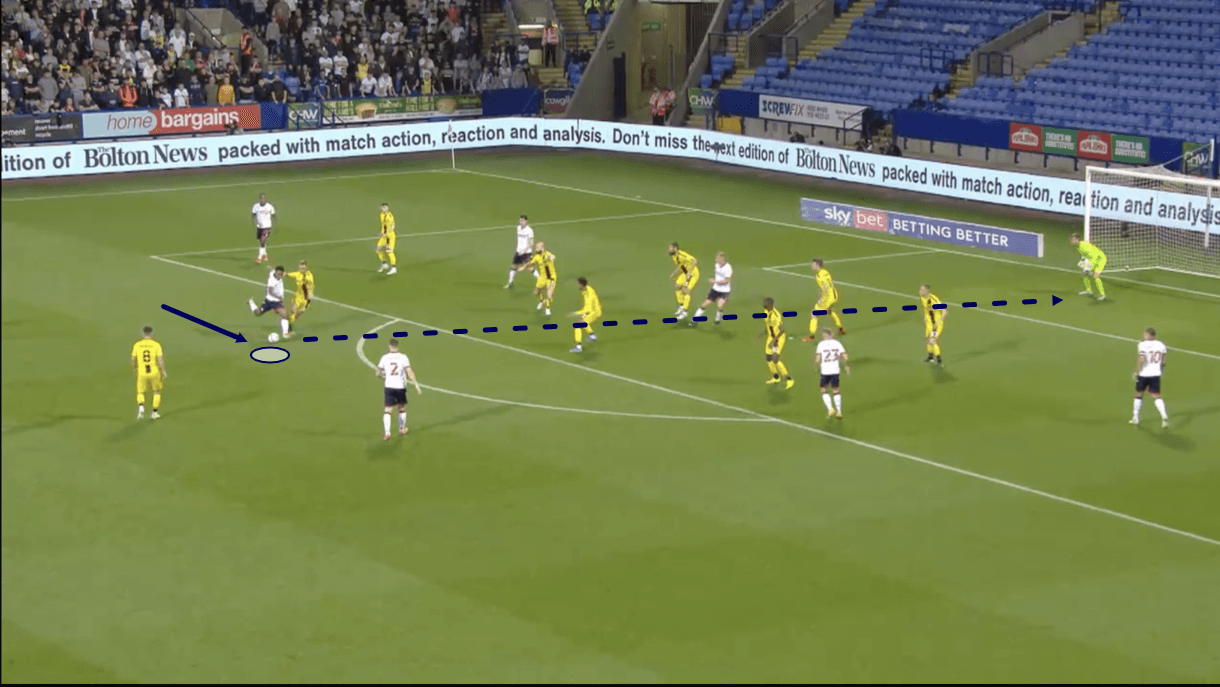
Figure 12 shows one of Afolayan’s typical shooting positions. As we know, he loves to occupy the right half-space. Specifically, during the chance creation phase, he loves to be positioned just outside of the box in the right half-space. He’s good at finding space in this position, as we know, and along with linking up with teammates via quick short passes, he loves to take long shots from this position when he has the space to do so, as figure 12 highlights.
Afolayan is excellent at creating the space for himself to get a shot off in this position, however, he often chooses to direct shots into areas packed with opposition players, which can lead to the shots being easily blocked. A lot of Afolayan’s shots fail to test the opposition ‘keeper because they’re blocked by bodies in the penalty area, so while the potential upside is strong if he does succeed in sneaking the ball through a crowded area – which can limit the ‘keeper’s vision and maybe even send him the wrong way as a result of a favourable deflection – the frequency with which this works out is not enough to justify the amount that Afolayan does hit shots into crowds of players, losing possession and giving the opposition a chance to counter in the process, so shot selection when faced with a crowd of players ahead of him may be something for the Bolton attacker to work on and consider.
One positive about Afolayan’s tendency to hit shots from outside the box, however, is that he’s great at hitting shots with a lot of power while keeping them down. He seems to be very conscious of the fact that powerful shots can end up getting skied but his awareness of this fact is a positive, as it helps him to regularly make very conscious attempts to keep shots down. Despite taking many long shots, he is good at keeping the shots down.
However, one other thing to note about Afolayan’s long shots is that his shot power fluctuates quite a bit. He likes to hit powerful, low shots from outside the box. In general, his goal tends to be to hit shots hard and low – and most of the time he manages to keep them low, but the power varies quite a lot. When his ideal shot comes off – hard and low – it’s a very difficult one to stop as the ‘keeper must quickly get down into his corner to keep it out. However, Afolayan does tend to hit weak shots from outside the area, resulting in his shots failing to test the goalkeeper too much and ultimately just dribbling into the ‘keeper’s hands.
Again, though, when Afolayan succeeds with getting the desired power on his shots, he presents a big long-shot threat to the opposition, so, to an extent, Bolton’s decision to give him such freedom to shoot so regularly is a bit of a high risk-high reward scenario. If Afolayan can work on achieving more consistency with his shot power, then Bolton’s trust and faith will undoubtedly be justified in the long run so this is something for the player and his coaches to think about and perhaps work on improving on the training ground.
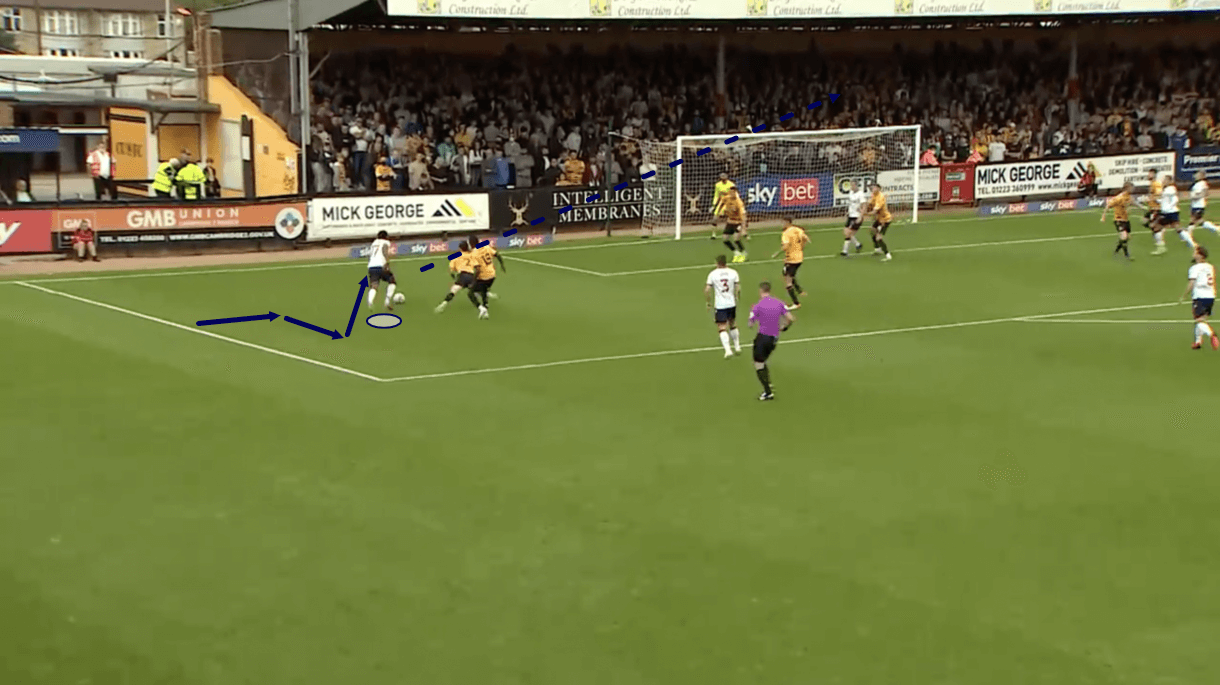
It’s also common to see Afolayan taking shots from tight angles, which figure 13 provides an example of. Here, the attacker has just dribbled into the box and sent an opposition defender falling to the ground thanks to his tricky dribbling ability. Afolayan initially turned outside and looked like potentially setting up either a shot or a cross on his favoured right foot. The opposition full-back followed him, but as soon as Afolayan demonstrated his agility by quickly turning back in the other direction, the defender struggled to keep up and ultimately fell over himself – again, highlighting Afolayan’s impressive dribbling quality from a technical and physical perspective.
This leads to the situation we see here, where Afolayan can progress towards the six-yard box after passing this defender and getting into a dangerous position. However, the shooting angle from this position is very tight and the shot ultimately fails to hit the target.
Afolayan is sometimes wasteful with the ball inside the box because he decides to shoot from very tight positions. In this passage of play, for example, a hard low cross may have been the better decision simply due to the tight angle which made it difficult to hit the target, let alone beat the goalkeeper.
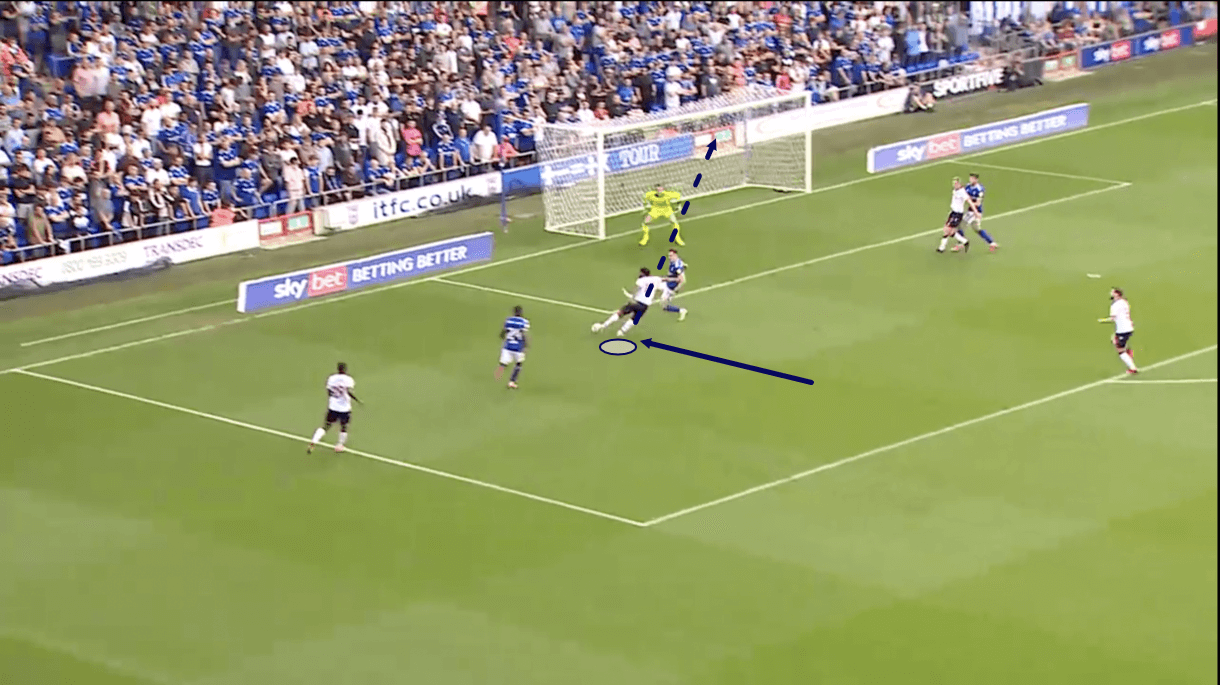
Afolayan can shoot effectively from awkward angles, which was the case in figure 14, however. Here, like in figure 13, Afolayan progressed into the box via a dribble and ended up in this position at the left corner of the opposition’s six-yard box – a position you’ll frequently see him end up in. Despite the angle being relatively tight (though not as tight as the angle he shot from in figure 13), Afolayan sends the ball into the goal by putting it through the defender’s legs and into the far side of the net.
This is a difficult finish to pull off. However, as mentioned, he’s good at keeping shots low and all going to plan, hitting them with great power too. So, when he pulls that off in this kind of position, the ball doesn’t need to go all the way into the far side of the net to beat the ‘keeper as he has very little time to react if the shot is low, hard, and on target. Afolayan does not need to just stop shooting from tight angles altogether at all – he’s proven that he can score from these positions. However, at the same time, there’s a big difference between figures 13 and 14, in terms of the angle – where 13 is even tighter with the player positioned wider – and in terms of the other options available, where in figure 13 the cross was on with several teammates in support and in figure 14 a shot does seem like a logical decision.
To be clear, Afolayan is a goalscorer and he absolutely needs freedom to shoot when he’s in these kinds of positions. There is ultimately no point in having a goalscorer like him inside the box and restricting him too much because he can score from positions as we see in figure 14. However, his efficiency may improve if he varied things up more as he does with his positioning, dribbling, and crossing, depending on the situation, how good the shooting opportunity is, and what other options are available for him. More considered shot selection and actions inside the box could help to make improvements in Afolayan’s shot efficiency and improvements in his overall goal contribution if he’s providing better opportunities to teammates so it is just something for him to be aware of and potentially consider as an alteration to his very exciting and impressive attacking game.
Conclusion
To conclude this tactical analysis and scout report, we feel it’s clear why Bolton boss Evatt believes that Afolayan is an exciting talent with “a big future”, as the 24-year-old has been a revelation at the Macron Stadium and currently looks too good for League One. Afolayan can run Bolton’s attack with his high volume of dribbles, thanks to the intelligent movement and impressive dribbling quality, both in terms of his physical ability and technical ability, which is frequently on display.
The attacker is an excellent and agile dribbler, an excellent reader of the game with a good understanding of space, and a dangerous shooter. While his shooting can be inconsistent in terms of power and accuracy, it’s clear why he’s given such rein to shoot so often with Bolton, as he’s currently the Trotters’ top goalscorer in League One and he’s been a consistently reliable goalscorer throughout his playing career. If that continues this season, then it’s hard to imagine Afolayan spending very long in League One, whether that’s by helping Bolton to get promoted or otherwise.





Comments